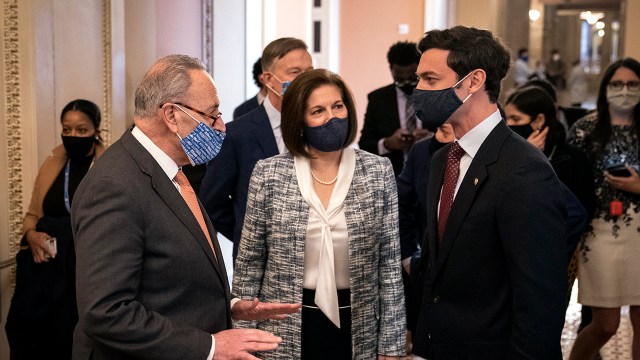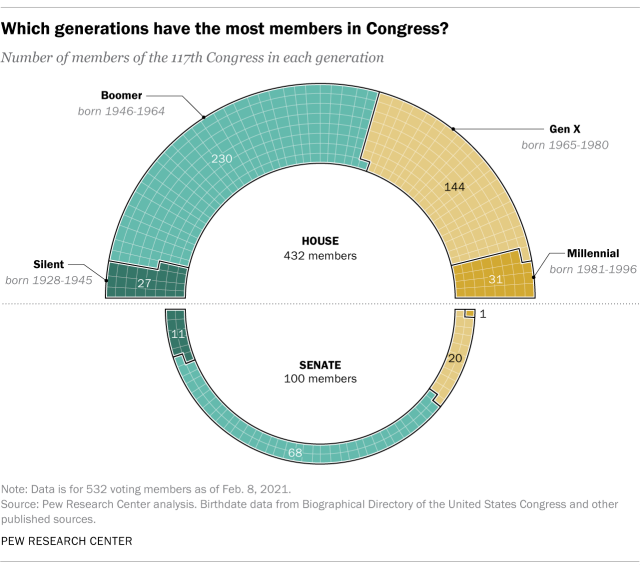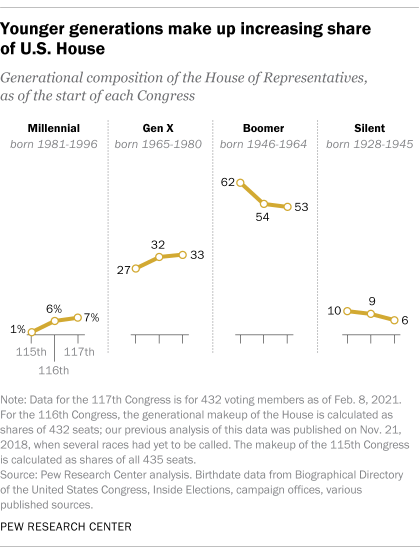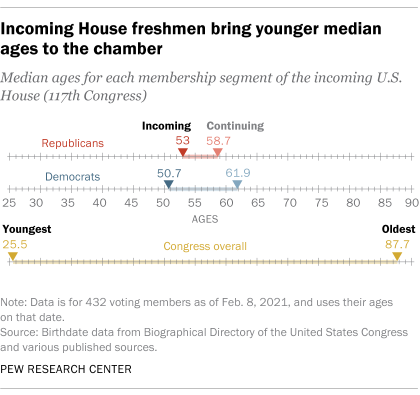
The number of Millennials and Generation Xers in the U.S. House of Representatives rose slightly with the new 117th Congress, though less so than with the 116th. And even as these generations gain representation in both chambers, older generations still make up the majority of senators and representatives.
For this analysis, we obtained ages and birthdates of members of the 117th Congress from the online Biographical Directory of the United States Congress and other published sources such as The Hill’s new members guide. Historical data for the 115th and 116th Congresses came from campaign websites, candidates’ offices or from reputable published sources (most notably the series of “candidate conversations” conducted by political analysis firm Inside Elections).
Our analysis of the 117th Congress reflects the 532 voting members of Congress seated as of Feb. 8, 2021, and ages are as of that date. In the House, one Texas seat is vacant after a congressman died on Feb. 8, and one Louisiana seat is empty because the congressman-elect died before being sworn in. The last House race to be decided (New York’s 22nd Congressional District) is included here. We did not include former Louisiana Rep. Cedric Richmond, who resigned in January to join the Biden administration. Nonvoting delegates and commissioners are excluded. Biden administration nominees who were not yet confirmed at the time of writing are included in our count. Independent members of Congress are counted with the party they caucus with.
For the 116th Congress, the generational makeup of the House is calculated as shares of 432 seats because our previous analysis of this data was published on Nov. 21, 2018, when several races had yet to be called (ages were effective Jan. 3, 2019); Senate figures are based on all 100 members seated as of Jan. 3. Calculations for the 115th Congress are based on the 435 House members and 100 senators active Jan. 3, 2017, and ages are as of that date.
Republicans added more Millennials and Gen Xers (28) to the House in this election cycle than Democrats did (10), according to a Pew Research Center analysis. By comparison, in the 116th Congress, 46 of 64 new Millennial and Gen X House members were Democrats.
The latest election cycle brought the House its youngest current representative (Madison Cawthorn of North Carolina) and the Senate its first Millennial (Jon Ossoff of Georgia).
In the new Congress, 31 House members are Millennials (born between 1981 and 1996), up from only five at the start of the 115th Congress in January 2017. Overall, 11 of the 61 new House members are Millennials, bringing that generation’s share of members in the chamber to 7%. Seven of those 11 new members are Republicans.
Twenty-seven of the new representatives are from Gen X (those born from 1965 to 1980), making them the highest share among the new members, and most of them (21) are Republicans. That brings Gen X’s share of the House to 33% (144 members, little changed since the last Congress).
Though there were only minor shifts in the age demographics from the 116th House of Representatives to the 117th, the shares of Baby Boomer (born 1946 to 1964) and Silent Generation (born 1928 to 1945) members have continued to decrease in the House since the 115th Congress.
Boomers make up 230 voting members (53%) in the House, down from 270 representatives (62%) in the 115th Congress. And the ranks of the Silent Generation continue to dwindle, from 42 (10%) at the start of the 115th Congress to 27 (6%) now.
In the Senate, Boomers remain the majority (68), and their numbers have risen slightly from the last Congress (66) and the prior one (65). The number of Silent Generation senators has fallen from 19 in 2017 to 11 now. But the number of Gen Xers has ticked up over the last few Congresses, from 16 in the 115th to 20 in the current session.
The median age of senators has risen over the last several Congresses. The median age in the current session is 64.8 years old, a slight increase from the 116th (63.6) and 115th Congresses (62.4).
Among House members, meanwhile, the median age ticked up slightly to 58.9, compared with 58 in the 116th Congress and 58.4 in the 115th. The median age of all new members is somewhat lower, at 52.1.
When comparing the ages of new and continuing House members, the gap is widest among Democrats, who as a whole have a median age of 60.6. The median age of the 206 Democrats who were reelected is 61.9; the 17 newly elected Democrats have a median age of 50.7. This gap is not as pronounced as in the previous Congress, when the continuing Democrats had a median age of 64.3 versus a median of 45.8 among newly elected Democrats.
The 165 Republican House members continuing into the 117th Congress have a median age of 58.7, while the 44 new GOP representatives have a median age of 53. For all Republican House members, the median age is 57.3. As with Democrats, the age gap between new and reelected GOP members is narrower than in the 116th Congress, when continuing Republicans had a median age of 58.4 and new GOP representatives had a median age of 48.9.
Previous coverage
2018: Millennials, Gen X increase their ranks in the House, especially among Democrats



